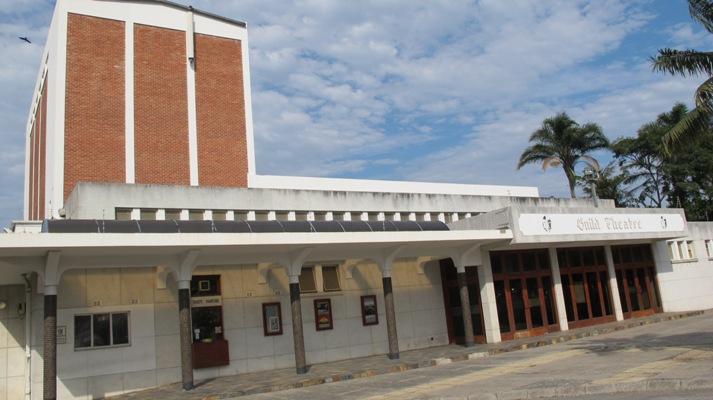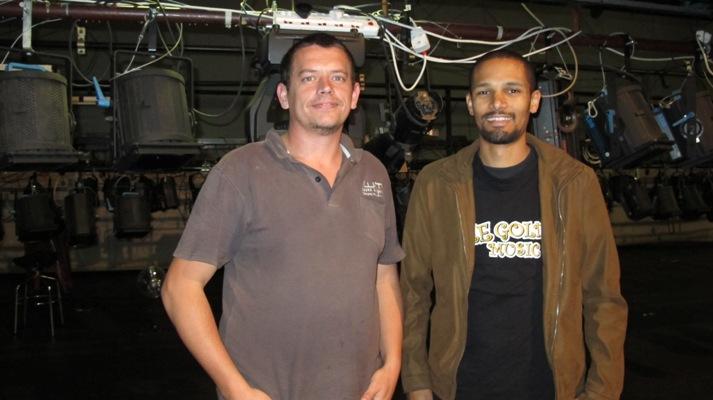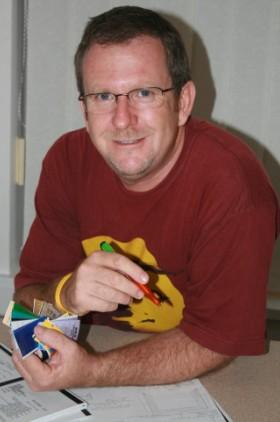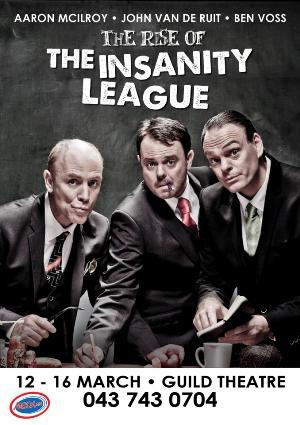16 October 2013

Images courtesy The Guild Theatre
If one had to allocate the epicentre of the Performing Arts in East London – a city that lies on the Indian Ocean coast, largely between the Buffalo River and the Nahoon River and which hosts South Africa’s only river port – the Guild Theatre would come to mind in a heartbeat.
Happy Birthday to this very special theatre which celebrates her 51st birthday in October.
From the exterior, you would not look at the Guild Theatre twice. It simply has no façade of monumental or majestic appearance. But, step inside. Meet the humble, yet willing crew headed by the Theatre Manager, Zane Flanagan. Look at the billboard and the endless posters and announcements. The Guild Theatre is the core of the East London local community. “The Guild Theatre family is small but a devoted one!” said Flanagan.
 Zane Flanagan, Theatre Manager at The Guild
Zane Flanagan, Theatre Manager at The Guild
History
It makes interesting reading to discover the history of the Guild Theatre, which opened its doors in October 1962. Thanks to the Wikipedia encyclopaedia, one learns that after the end of the Second World War, Dr Bromilow Downing and another East Londoner, Arthur Markson, got together in 1953 and formed the East London Guild Theatre Association (often referred to as the Theatre Guild), with the idea of initiating interest in building a proper theatre in East London.
Soon the Association comprised over 1 000 members affiliated to societies from around the city – the Afrikaner Club, Association of Arts, Church Drama Club, Dramatic Society of East London, East London Music and Variety Club, East London Technical College Drama Club, Komga Drama Club and the Philharmonic Society.
In 1954, the societies began raising funds to build what was then called the Civic Theatre or Little Theatre. The money was raised through performances at church and school halls and, according to a Guild Theatre Association report, “by receiving donations from various sectors”. It became a tradition to perform a pantomime each year in the East London City Hall, with proceeds going to the building fund.

As the money came in, the Theatre Guild Association challenged the then South African Government Department of Education, Arts and Science to match its funds pound (rand) for pound (rand). Until this happened, the theatre would be owned and managed by the Theatre Guild Association.
However, the Government’s response was that it would make funds available only if the Municipality of East London provided a loan towards the cost of the theatre, as well as assuming ownership of the theatre building.
According to a Guild Theatre report, “the Government finally granted the Theatre Guild Association R50 000, the City a loan of R50 000, while the Theatre Guild raised R58 000.”
In October 1962, the Guild Theatre opened its doors with a production of School for Scandal, directed by Mary Howe. Costumes were imported from London “especially for the occasion”.
Since that time, the Guild Theatre has been home to some of South Africa’s leading artists, emerging local performers, as well as several international acts.
The Guild Today

Andre Donaldson and Jonathan Fortuin from The Guild.
In keeping with its philosophy to instil a passion for the Performing Arts, the Guild Theatre opens its doors to school and ballet productions. “Children come back every year, or you may bump into them in town when they approach you to ask if you remember them,” says Jonathan Fortuin, a stage technician at the Guild Theatre.
While many schools use the Guild Theatre for their year-end productions, there are those who simply cannot afford the overall cost of doing so. Jonathan Fortuin and Andre Donaldson, the stage manager and lighting operator, earlier this year took The Guild to Gonubie High School, who staged an Easter production at the school. The Guild Theatre used their grandma on on PC to enhance the performance. Gonubie High loved it!

“While the Theatre is small and a lot more personal than larger ones, the big names still come around – like comedian Trevor Noah,” says Fortuin. Once the artists meet the stage team, they soon feel right at home. It’s all rather surprising how the theatre runs, and one is again reminded that the Guild Theatre is not about equipment, but rather about people.
“It’s refreshing to come across a small theatre, community-based, that is still relevant and provides such a great service to the community,” commented Dave Whitehouse from DWR, who has had a long association with The Guild. “At the same time, the theatre manages to attract both national and internationally-renowned artists.”

Memories are made of these
Whitehouse has many fond memories of lighting both the opening season productions, as well as numerous shows with the likes of David Matheson, Professor Elizabeth Trichardt and Colin Ward, amongst others.
“At one stage, I lived in East London for six months on and off because I used to light all the shows,” Whitehouse recalls. “The Guild Theatre has always been a friendly place to go and the staff are extra helpful compared to anywhere else. Back then, Zane Flanagan was working in the box office. It was his first job and he went on to become Theatre Manager. He is a humble guy, but it’s interesting that, in times when people change jobs often, Zane stays because he loves the theatre. He has a passion for it and that is why he is still there – after 23 years!”

Dave Whitehouse, DWR
In 1987, the Cape Administration Performing Arts Board (CAPAB) bought the Guild Theatre for R2. “It was actually the minimum fee you could provide transfer for,” comments Whitehouse. “CAPAB wanted a permanent presence in East London. The venue was virtually gutted, re-developed and re-equipped. The dimmers and the control desk came from Chris Grobler and a certain Dan Riley who, I think, in those days worked for Zumtobel. The control desk was a Strand Gemini, the first one in the country.”
Whitehouse remembers going to East London for the first ballet at the Guild Theatre, which he recalls NOT lighting, and Hello Dolly, starring Judy Page, which he did. “Then we did a straight play, Wait Until Dark.” He smiles: “The first 10 minutes of the play is just light from a fridge door and nothing else. It was scary. It really was an excellent, excellent play.”
CAPAB would take shows from Port Elizabeth to East London and vice versa. They were very involved with the community and the shows were packed – you could not get seats.

Some 51 years down the line, the future of the East London Guild Theatre is bright. “Led by Zane and his team, it can only go from strength to strength,” said Whitehouse.
In December, the Guild Theatre will be staging Disney’s Beauty and the Beast directed by Amanda Bothma with a talented local cast of singers and actors.




